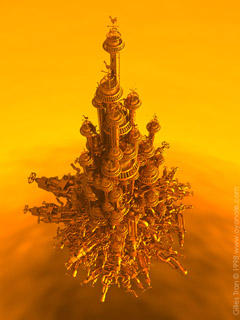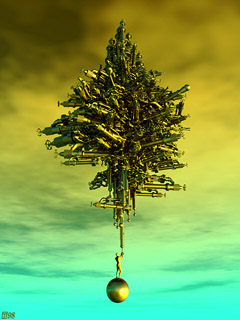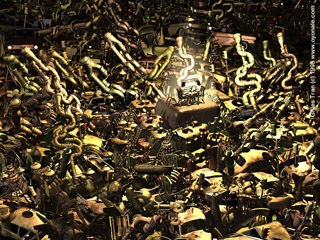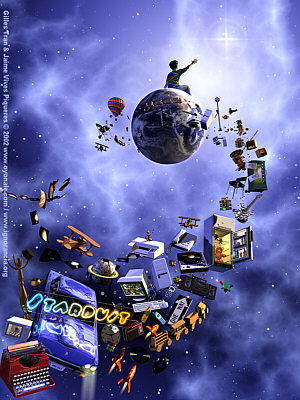Note: if you are not familiar with the way computer images are created, please click here for some basic definitions and explanations.
The email that started it all
Like so many stories today, it started with an email exchange.
Mark Shuttleworth, a 28-year old South African Internet entrepreneur and ray-tracing enthusiast, had bought all the Internet Ray-Tracing Competition CD-Roms. He and Chris Cason, the Australian co-ordinator of the POV-Ray development team, got along pretty well, and by the end of 2001 they had been chatting together by phone and email for the past 6 months.
One day, Chris wrote to his friend:
- It'd be cool to be able to say POV-Ray was the first raytracer in orbit ;)
To what Mark answered:
- Of course! Will do that with pleasure. Let me know what you want rendered!
Between two other people, that would have been nothing more than a passing joke. But it wasn't.
On December 13, 2001, fellow Spanish POV-Ray artist Jaime Vives Piqueres (www.ignorancia.org) and I received from Chris Cason an invitation to the most amazing art project any of us had ever participated in: on the ground of our previous work (both of us have won the IRTC several times), we were asked to propose an image to be rendered in the International Space Station.
One thing I know about Chris Cason from his on-line personality is that, while he has a nice sense of humour, he doesn't play Internet pranks. He doesn't say silly things either (in fact he's annoyingly quick to spot the silly things people say). Even his little question about raytracing in orbit was asked only half-jokingly. But his invitation was hard to believe nonetheless. Jaime and I are quite unknown outside our circle of friends, relatives, colleagues, customers and POV-Ray amateurs. POV-Ray is a nifty little piece of software that rarely gets more than a nod from the big boys of computer graphics. Still, suddenly, the three of us were getting involved in the space program, at least symbolically. It just didn't make sense.
8 hours later, Jaime sent me an email asking if I was still checking the headers of Chris' message in case someone was having a joke on us. For his part, he was still digesting the invitation. Thanks to furious googling, though, it appeared that there was indeed a man called Mark Shuttleworth, who, in 1995, his final year at University of Cape Town, had founded Thawte Consulting. This company had quickly become the leading Internet Certificate Authority outside of the US and he had sold it to Verisign in 2000 for an amazing amount of money. This had made him rich enough to buy a $20-million ticket to the International Space Station. He would be, in April 2002, the first "afronaut" in history and the second "space tourist" - an expression he doesn't like - after the American Dennis Tito.
There was also, to our relief, ample indication that for all his millions he was a nice guy, intent on spending his fortune to help his homeland and Africa through foundations, charities and venture capital. And since Chris Cason himself was answering our emails, it meant that it was a true invitation after all.
The challenge
With Mark Shuttleworth having a fun time in Star City with the "Vomit Chair", the "Vomit Comet" and other torture machines of Russian design, we were quite free to do what we liked from an artistic point of view. Chris wanted the picture(s) to be eye-catching, the sort of image people would be willing to hang up on their walls even if it wasn’t rendered in space. Little was known about the type of computer Mark would be allowed to bring on board, apart that it would be a laptop of an earlier generation, i.e. not extremely fast and probably without that much RAM. But above all, the picture had to be rendered in a limited time, between 35 and 50 hours, possibly when Mark would be sleeping. And because we would make a poster out of it, the rendered image had to be very large.
For Jaime and I, that was the main challenge (though not as challenging as being submitted to the Vomit Chair?). Both of us love to create complex, detailed scenes, with as many objects, textures and sophisticated lighting we can cram in. In terms of raytracing, this means days, sometimes weeks of render at screen size. But here, the picture had to be a hundred times larger, run very quickly and still be appealing: a simple calculation (8000 x 6000 pixels divided by 35-50 hours) gave us a minimal speed requirement of 300-400 pixels rendered per second (pps). Our usual pictures sometimes render at less than 10-20 pps! This ruled out most of the fun things we had been playing with recently, such as volumetrics, global illumination, isosurfaces or focal blur, and generally speaking any attempt at photorealism. In other words, we would have to create the image using rather old-fashioned but fast and not resource-consuming techniques.
Another thing that was left to our choice was our own work organisation. Neither Jaime and I had worked on a collective picture before: we both like to do things ourselves and be free to tweak images forever, or even put them on stand-by for a while until we get inspired again or real life allows it. It turned out, fortunately, that our respective tastes were complementary. Jaime loves to model real-life objects using painstakingly crafted constructive solid geometry (CSG) and complex procedural textures. I like to focus on image concepts and general composition, often using pre-made models and image maps. Of course, I can do my share of CSG and Jaime has a knack at lighting? This defined the way we would work together in the following months. And we would communicate in Spanish! Jaime, who manages his own domain, opened an ftp upload space so that we could exchange files easily.
We had a deadline too: the end of March 2002. The rocket wouldn’t wait for a couple of hobbyists to complete a picture.
Concepts
We quickly came up with two designs, both related to the event itself. In my interpretation, Mark Shuttleworth was living a child's dream. Us thirty-something have been raised in the aftermath of the Apollo missions. Mark Shuttleworth wasn't born yet, but I do remember seeing the LEM landing in 1968 (I was 4). While the present manned flights do not have the prestige of the moon trips, they still retain part of that dream. Mark Shuttleworth and his predecessor Dennis Tito have been criticised for what looks like billionaires' follies, but this may be the only way of burning cash that I can understand! Watching the stars is after all one of the oldest human occupations, and wanting to go there is a common, respectable dream. I didn't have to work hard to build a fictional version of Mark Shuttleworth, as the quintessential human being - a child - leaving behind him his hard-earned terrestrial possessions to go per ardua, ad astra, as it the motto of the Royal Air Force and other Commonwealth air forces. The truth was not so remote, in fact, as Mark Shuttleworth made it clear in later interviews that his trip to space was "simply about doggedly realising a boyhood fantasy" (The Guardian, November 30, 2002).
Now the question remained, how to turn this into an image? The first concept was curiously derived from something quite unrelated, a painting I had done in 1989 in my pre-raytracing days, which was a dark, humorous (?) and contemporary take on heroic fantasy heroes besieged by hordes of monsters.
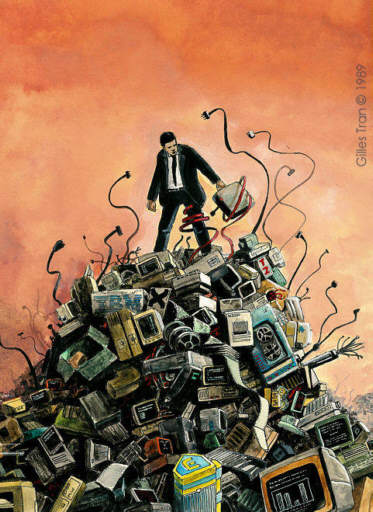
Piling up 3D junk with controlled randomness can give the impression of complexity while actually saving both on building time and on rendering time. I had used this trick several times before with some success.
Click on the thumbnails to see a larger image.
So the first space image would feature a little mountain of technological garbage, made of the many objects the child would leave behind. The child would be on the top of the heap, watching the stars. I toyed with the idea of having two kids of opposite sexes, or having a girl or a young woman instead. A female character had certain marketing advantages? But since the whole story was about a boy, a boy's picture it stayed.
The second concept was linked to the previous one. It represented an astronaut looking at the Earth through the porthole of the space station. The station would have been low-tech, with wooden panels and shining brass instruments, like the flying machines in Jules Verne's books, Albert Robida's pictures or Hayao Miyazaki's Castle in The Sky. This idea, unfortunately, was never realised due to lack of time.
First drafts
We drew a list of the items that we would need to build the "hill" of junk and came up with 40 props. Some already existed, others would have to be created for the purpose. The list allowed Jaime and I to work separately from now. He would spend his time on creating extremely detailed props (one cannot cheat with a 6000 x 8000 image!) while I would try to find a way to turn the concept into something pretty.
I first worked on the "hill", borrowing stuff from my 10-year archives of models to be used as final props or placeholders that would be replaced by Jaime's objects or mine. Micha Riser's POV Object Collection provided a few minor items. Chris Colefax's Galaxy macro would make a nice starry background. Finally, I had already bought the Millenium Kid, his hair and clothes, all Poser models sold by DAZ.
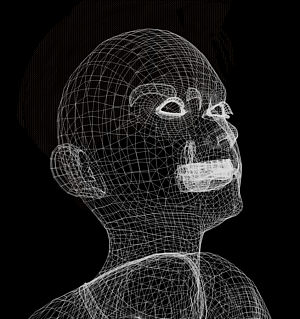
Thus equipped, I organised the props in a cone, and put the kid on the top, like the groom on a wedding cake. Making poster-size images is harder than making screen-size ones, because it is necessary to work at different sizes: small ones to get a general view of the image and close-ups to make sure that the details look good. Below is version #3 of the image and a close-up of the kid from another version.
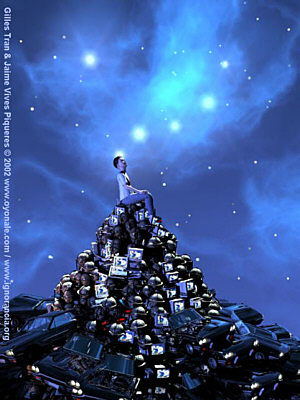
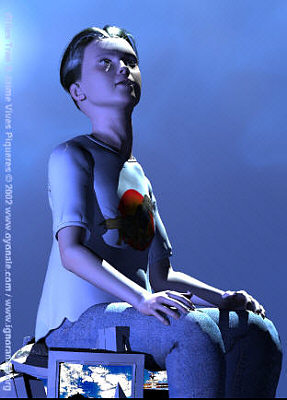
The detail shows some of the issues with the child model: it is plastic-looking, it has a bizarrely twisted neck and there's an ugly lighting artefact on its face. Even with a good Poser model such as this one, finding the right pose and expression takes an enormous amount of time, because each time a pose is tested the model must be exported, converted and imported in the POV-Ray scene to make sure that it looks OK. The whole cycle took a few minutes on my PIII, and was repeated dozens of times. As we'll see, I never found a proper way to have the kid face the viewer.
In fact, the background was the only satisfying thing there. Eventually, I took the Galaxy macro apart (and learnt a few things in the way) to extract what I needed and fix some problems, but the macro was always amazing to play with. Below is version #4, with a different lighting.
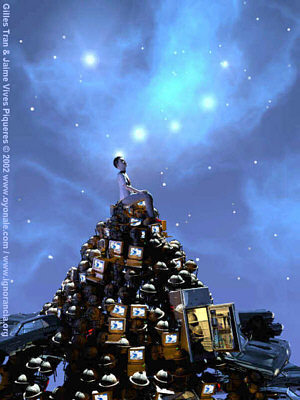
In any case, it didn't work, for several reasons. The kid was a nightmare to work with due to bizarre positions and artefacts. The "hill" was terrible to control. What worked on an 800x600 image wouldn't work on a poster-size one. Objects were colliding with each other and this was too visible at close range. While automatic collision detection works on simple shapes, the only way with complex objects was to set it up manually, and we were definitely not going to place 200-300 objects by hand. Lighting the hill was also a problem: it was always too dark or too light and objects were difficult to see. Due to the constraint on rendering time, we couldn't use soft shadows to get rid of some of the darkness. In any case, rendering times were going up. Jaime's CSG objects were full of details and reflective parts, and dozens of objects like this kind meant unacceptable render times.
Meanwhile, Jaime was working on his props. I bought Rhino, spent some time learning it and eventually made a few objects with it. Fabien Mosen was asked to contribute some of his great music props for an "ultra-top-secret project" I couldn't tell him about!
New beginnings
At the beginning of 2002, real life took over and Jaime and I could only resume work on the image by the end of February. With the deadline approaching and with so many problems plaguing the current concept, I had to come up with something new. So I got rid of the whole hill concept and stored it away in my secret trunk of false good ideas.
The kid was promoted from king of the hill to Little Prince of Earth. It gave the image a more symbolic value: the kid was sitting on the top of everything and reaching for the stars, leaving behind him a trail of childhood toys and discarded technology looking like space garbage. This solved several problems at once. Most of the picture area was now filled with a sky pigment, so the rendering times went down and we could safely add more complicated props. The kid was turning his back to the viewer, so his plain, artefact-ridden face was no longer to be seen. By arranging the props along a trail going from the bottom of the image to the Earth, the placement and collision problems were minimised. Earth maps for the lands, clouds and nightlights were found in the Nasa websites. Version #6 is presented below, with real and dummy props.
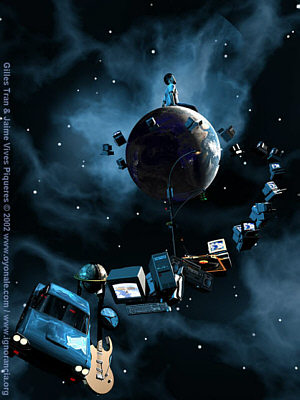
Development
A lot of lengthy, painstaking experimenting went on, trying to find the right colouring, balance, positioning of props etc. The background was lightened, and the Earth was shrunk again and again to make the image more dynamic. Versions #7 and #8 (the latter with a different colour scheme) are presented below.
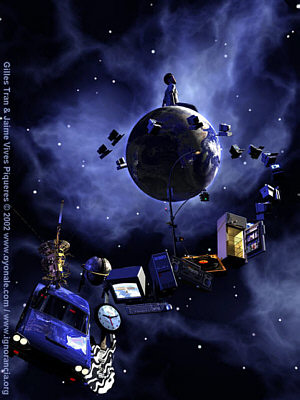
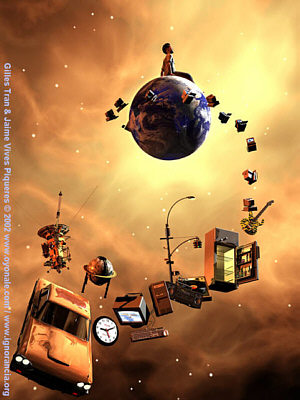
All the props went into an array that was distributed along the trail, so when Jaime or I added a new one it was easy to replace the dummy by the real object. The props were tweaked and tweaked again, adding details and changing textures. Most of the light sources were now local, illuminating a single prop.
Several references were made to the South Africa: the kid was now wearing the South African colours ; the banknotes flying out from the safe are Rands (thank to web sites that buy and sell banknotes for collectors and put the images on-line). The nightlights below the kid are the one from the big South African cities, a premonition of what Mark Shuttleworth would see during his flight:
"I remember looking at South Africa: it was like a filigree of gold, the towns, the lights, the highways. I could see Cape Town, then up the coast to Knysna, George, Mossel Bay, Port Elizabeth and Durban, then to Joburg and beyond that the smaller clusters of Maputo and maybe Harare. And that was it, beyond that there was very little." (The Sunday Times, June 2, 2002). Mark had time to admire the landscape, as he had managed to ruin his camera while trying to change the memory card in the dark!
We also put references to the world of raytracing, like the little sphere over a chequered plane in the micro-wave oven, the Utah teapot and "POV-Ray" and 'POV" written in several places.
The little rockets were put there because they reminded us of the Tintin one (a reference for many Europeans), but it turned out that Mark had played with rockets too: "When I was
young, I used to experiment with different mixtures of rocket fuel to try to build my own small rockets" (interview from the African in Space website).
On March 11, 2002, #version 17 was ready and sent to Chris Cason.
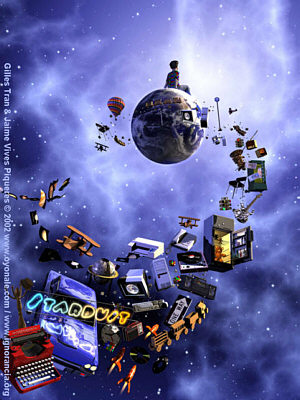
To our relief, he liked it and made a few suggestions. The logotype of African In Space, Mark Shuttleworth's space project, was added. The kid's position was changed so that he now seemed to be reaching for the stars. This was a big improvement on the original concept because we now had an active kid instead of a passive stargazer, something which, in retrospect, fitted Mark's adventure and underlying philosophy much better.
"If we can motivate and inspire South African people to reach for the stars, it will be easier to carry the burden of HIV / AIDS in South Africa." (Interview from the African In Space website)
The changed movement also proved a little bit difficult to implement, because his previous position had allowed me to camouflage the lack of a proper skin finish in POV-Ray. Skin is a difficult material to render, because the real thing has several layers that interact with light. With the kid's arm positioned against the star's light, the regular texture looked plastic… So I separated the arm from the body, increased it resolution x 4 (to prevent some artefacts) and filled it with volumetric media to simulate the scattering of light in the deeper layers of the skin. The right arm had now a better texture, but different from the rest of the body… However, then there was little I could do as we were running out of time.
Version #20 was completed on April 12 and the 80 Mb of files were uploaded to Chris Cason's server.
He sent the files to Mark Shuttleworth in Russia, along with a customised version of POV-Ray designed to run in orbit. Chris introduced in this version a mysterious feature called "Duty Cycle". The official version now has it too and the Help explains what it does as follows : some computers - particularly laptops or notebooks - cool their CPU's by convection, and this makes them prone to overheating in circumstances where the circulation of air is restricted, such as in a confined space, or where hot air does not rise, such as in zero-gravity. POV-Ray makes extensive use of a processor's Floating Point Unit (FPU), a portion of the CPU that is not normally prone to high activity over long periods. Such use can potentially cause the CPU to generate more heat. Additionally, high CPU activity can cause the unit's normal heat-reducing facilities (such as lower-power CPU modes) to be inactive. The Duty Cycle setting is used to tell POV-Ray to only use a certain percentage of the CPU's available time, even if nothing else is competing for the CPU. For example, a duty cycle of 10% would cause POV-Ray, during a render, to sleep for 90% of the available time, and only render during 10% of it. That strange little feature prompted a few questions in the POV-Ray newsgroups…
The orbit: there and back again
On April 25, 2002, after 8 months of full time training, Mark Shuttleworth was blasted into space in a Soyuz capsule, from the Russian cosmodrome of Baikonur, with Russian flight commander Yuri Gidzenko and Italian engineer Roberto Vittori. Mark was certainly more than a tourist and, during his flight, he conducted scientific work on the International Space Station, including stem cell, embryology, and HIV virus experiments, as well as examinations of ocean life. The event was quite publicised and the whole story can be read at Mark's own www.africaninspace.com web site.
Let Mark Shuttleworth himself talk about the rendering:
"I took TWO laptops into orbit. They were IBM A22p laptops, P-III 1Ghz machines with 256MB RAM. The 'standard certified' machines up there were Pentium-166 IBM Thinkpads, which were known to handle the radiation and heat convectionless environment quite well... but we couldn't find any of those laptops anywhere, they are too old and out of production. So I took the decision to take a risk and take up brand new ones. The Russians gave me permission based on the fact that there were no obviously new plastics or materials that might cause a problem, and the battery technology was known to them... Certifying a new laptop through ESA or NASA would have cost a fortune, but the Russians took the view that it wasn't mission critical for them, there were no major risks, and if it worked then they would have two new laptops on orbit that were much faster than anything else up there.I was very worried that they would be prone to radiation damage because the chip features are so much smaller on recent laptops than they are on P-166's, so there was a risk of memory and processor errors from ionising radiation in orbit. Also, they have higher heat generation issues and there are lots of stories of heat being a problem for commercial-off-the-shelf hardware that is taken to space... in space, hot air doesn't rise. So that was why I wanted a compute-intensive process to hammer the laptop's memory and hardware, to see if there were any problems.So when I got to orbit, the first thing I did was patch the laptop software to latest versions of everything, using a CD I had burned the day before launch in Kazakhstan, and data files on CompactFlash cards and IBM microdrives. Then I fired up POV and started running the render on the first notebook. The theory was that if there were errors, they would show up first on the laptop that was running the computation and memory-intensive task first. So POV provided me with a sort of electronic canary, testing to see if the radiation/heat was going to be a problem for my main work laptop. I ran and ran the POV render several times... first without the pic, then with it, and never noticed any crashes or failures that would suggest a problem."
On May 2, Chris Cason received an email from Mark's support team, saying that he had rendered the image and that it had "worked like a treat".
Just before the end of the trip, Chris leaked the story in the povray.general forum. It was difficult to say more, however, because we didn't want to spoil the surprise. Also, everyone in the POV-Ray community was busy with the release of the long-awaited POV-Ray 3.5, so most minds were elsewhere.
On May 5, Mark Shuttleworth and his fellow crewmembers landed safely in northwest Kazakhstan near the town of Arkalyk.
On May 25, Mark managed to send us an email, telling us of the several rendering sessions. For the last one, he had taken an picture of himself in orbit and added it to the script, so that the final image was now really distinctive from the one we had created (Chris Cason's idea actually). It can be seen below that while a respected flight participant, he was also "a permanent human guinea pig" for the physiology experiments.
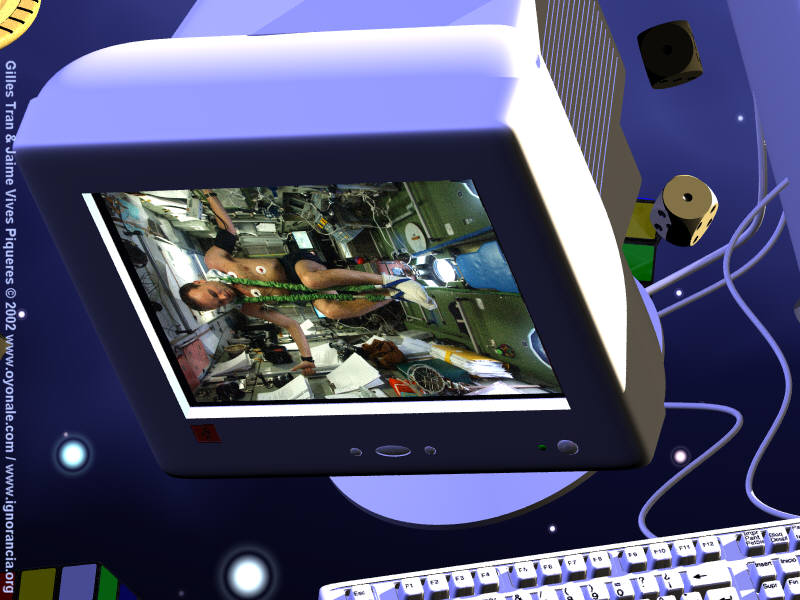
Then we waited. And waited.
Coming back to Earth, Mark Shuttleworth was quite busy. He first took some time off, travelling in Ireland with his parents, and then had to cope with his new-found celebrity - giving interviews, dancing with the president of South Africa, attending the World Economic Forum's regional Africa meeting in Durban - while going on with his entrepreneurial life on several continents. He ran around like crazy for a few months. Back home, he went on tour, a six-week roadshow around schools, focusing on poor rural ones, in an attempt to use his trip into space to inspire an interest in maths and science. The show, called hip2Bsquare, featured a mobile stage, a model of the Soyuz rocket, a mad scientist who blew things up, a DJ and a graffiti artist.
His laptop with the images on it was "captured" by Russians, and later sent to the Americans at Lockheed for another round of analysis. When Mark got it back in Automn 2002, it wasn't in good shape and missed some parts, so he couldn't send the files right away. In fact, he couldn't see his own photographs taken in space either.
Finally, on January 9, 2003, Mark was able to find the missing cables and upload the files to the POV-Ray server.
In the foreword to the Right Stuff, Tom Wolfe says that his book, which covers the early days of the US space program, grew out of the question: "What makes a man sit up on top of an enormous Roman candle and wait for someone to light the fuse?". On February 1, 2003, the Columbia shuttle catastrophe came to remind everyone that going to space is still a bold and dangerous venture.
Even in our days of "space tourists", only the few hundreds who made the trip know the answer to Wolfe's question. The earth-bound rest of us can only dream of it, and make pretty pictures.
Epilogue
In conclusion, let's quote Mark Shuttlework again:
About the image:
"Let me conclude by saying thank you for taking such an inspired approach
to the challenge. You really captured the spirit of the adventure... the
fact that it was about reaching for dreams, the south african-ness of
the effort, and the beauty of space. To have done all of that, and
created a beautiful work of ART, is an achievement."
About his adventure (interview from the African In Space website):
"I think everybody has dreams which seem to be out of reach. But the world is a surprising place, and I believe that people who strive for their dreams turn them into reality more often than not, if they are willing to work very hard, to take one step at a time in the right direction, and if they are willing to take risks when opportunity presents itself. Sometimes when those dreams don't come true we realise that we didn't understand ourselves well enough, and we see new and unexpected opportunities. But without dreams we don't make any effort to move forward... dreams are very important to all people, of all ages, in all countries."
Gilles Tran & Jaime Vives Piqueres © 2002 - This image was commissioned by Chris Cason www.povray.org